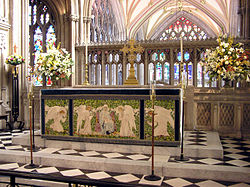This article needs additional citations for verification. (October 2010) |

An antependium (from Latin ante- and pendēre, "to hang before"; pl.: antependia), also known as a pulpit fall,[1] parament or hanging, or, when speaking specifically of the hanging for the altar, an altar frontal (Latin: pallium altaris), is a decorative piece, usually of textile, but also metalwork, stone or other material, that can adorn a Christian altar.
Antependium can also be used to describe the decorated front of the altar itself, especially if it is in an inflexible material such as wood, stone or metal.[2]
Specifically, and as the etymology of the word suggests, an antependium hangs down in front of whatever it covers, and is to be distinguished from the altar linens which are used in the service of the Eucharist, and an altar cloth which covers the top of the altar table (mensa).
The true liturgical decoration of the altar and its oldest adornment is the frontal.[3]
- ^ "Pulpit Fall". Textile Research Centre Leiden. 4 September 2016. Retrieved 30 January 2023.
- ^ Murrays, 364
- ^ O'Connell, J.B. (1955). Church Building and Furnishing: The Church's way A Study in Liturgical law. University of Notre Dame. pp. 192 –.